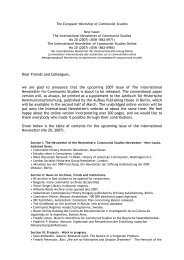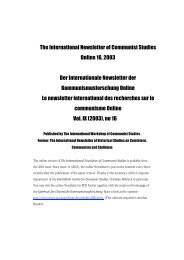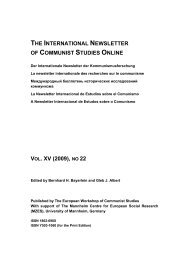Vol. XIII (2007), no 20 - The International Newsletter of Communist ...
Vol. XIII (2007), no 20 - The International Newsletter of Communist ...
Vol. XIII (2007), no 20 - The International Newsletter of Communist ...
Sie wollen auch ein ePaper? Erhöhen Sie die Reichweite Ihrer Titel.
YUMPU macht aus Druck-PDFs automatisch weboptimierte ePaper, die Google liebt.
<strong>The</strong> <strong>International</strong> Newletter <strong>of</strong> <strong>Communist</strong> Studies Online <strong>XIII</strong> (<strong><strong>20</strong>07</strong>), <strong>no</strong> <strong>20</strong> 136<br />
<strong>The</strong> idea to found a newspaper in Oulu was <strong>no</strong>t new in 1906, for the local labour association<br />
had in many occasions since 1898 made plans <strong>of</strong> its own paper but they were miscarried<br />
because <strong>of</strong> lack <strong>of</strong> money and editors, or by restrictions issued by the Russian authorities.<br />
Thus, the local workers were ready to take quickly advantage <strong>of</strong> the change <strong>of</strong> the situation.<br />
<strong>The</strong>y were also very confident in starting a paper which came out six times a week, though it<br />
was usual to start with three times.<br />
Kansan Tahto began its life as an organ <strong>of</strong> the Social Democratic Party (SDP). <strong>The</strong> abortive<br />
revolution and the Civil War in 1918 and the orientation after them created basis for the<br />
division <strong>of</strong> the labour movement in Finland. In spring 19<strong>20</strong> Kansan Tahto decided to leave the<br />
SDP which was re-founded in spring 1918 by those who had <strong>no</strong>t participated in the revolution,<br />
and to become an organ <strong>of</strong> the Socialist Workers’ Party <strong>of</strong> Finland (SSTP). Thus Kansan Tahto<br />
wanted to belong to the left <strong>of</strong> the Finnish labour movement which, besides the SSTP,<br />
consisted <strong>of</strong> the <strong>Communist</strong> Party <strong>of</strong> Finland (SKP) founded by the Red refugees in Moscow in<br />
August 1918 and forbidden in Finland up to autumn 1944. At that time the left <strong>of</strong> the Finnish<br />
labour movement was re-organised as the SKP became public and a new organisation,<br />
People’s Democratic League <strong>of</strong> Finland (SKDL), was founded. Kansan Tahto was an organ <strong>of</strong><br />
the latter from 1945 to its dissolution in 1990 and since then an organ <strong>of</strong> the Left Union. Thus<br />
Kansan Tahto has contributed to the large support <strong>of</strong> the leftist labour movement in Northern<br />
Finland and its past is an essential part <strong>of</strong> the history <strong>of</strong> that movement in the area.<br />
Though Kansan Tahto was born as a result <strong>of</strong> people’s active movement, it was <strong>no</strong>t in the<br />
habit <strong>of</strong> the paper to agitate people to direct actions. It has rather believed that the labour<br />
movement can achieve results through representative organs. That road was paved by Yrjö<br />
Mäkelin, the editor-in-chief <strong>of</strong> Kansan Tahto in 1907-1918 and one <strong>of</strong> the most famous<br />
newspaper editors in the early Finnish labour movement. Kansan Tahto did, however,<br />
occasionally give people’s direct actions preference. That was most evident in autumn 1917<br />
when Yrjö Mäkelin called for the people to take the power from the degenerated bourgeois<br />
class. That call was <strong>no</strong>t afterwards expressed as clearly on the pages <strong>of</strong> the paper. After 1945<br />
Kansan Tahto, as an organ <strong>of</strong> a government party, probably thought for a while that it was in<br />
power, but the illusion was dispelled in 1948, at the latest, as the SKDL was left out <strong>of</strong> the<br />
government. <strong>The</strong> newspaper was <strong>no</strong>t haunted by similar expectations in the 1960s and 1970s<br />
when the SKDL re-entered the government.<br />
<strong>The</strong> traditions <strong>of</strong> the general strike <strong>of</strong> 1905 have rather been evident in the fact that<br />
freedom <strong>of</strong> speech has been a very important issue for Kansan Tahto. Its importance has, <strong>of</strong><br />
course, grown as the paper itself has experienced the indifference <strong>of</strong> the authorities<br />
concerning that right; the newspaper has been banned in 1914, 1918-19, 1923-24 and 1930-<br />
45. <strong>The</strong> first ban was issued by the Russian authorities as the newspaper presented kind words<br />
about Germans, the enemies <strong>of</strong> Russians in the war, the latter by the authorities <strong>of</strong><br />
independent Finland because <strong>of</strong> “preparation <strong>of</strong> the revolution”. A great number <strong>of</strong> editors<br />
was also sentenced to prison for the same reason. <strong>The</strong> history <strong>of</strong> Kansan Tahto is thus full <strong>of</strong><br />
various difficulties but it also proves <strong>of</strong> the strong commitment <strong>of</strong> the workers in Northern<br />
Finland to their newspaper.<br />
<strong>The</strong> bans have contributed to the fact that Kansan Tahto has <strong>no</strong>t been able to shake the<br />
hegemony <strong>of</strong> the bourgeois press, though it has been <strong>of</strong> great importance for the working<br />
people in Northern Finland. In the 1910s its circulation was <strong>no</strong>t far from the largest bourgeois














